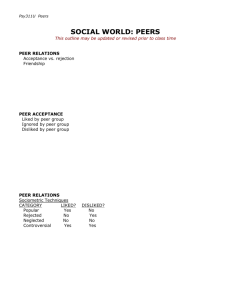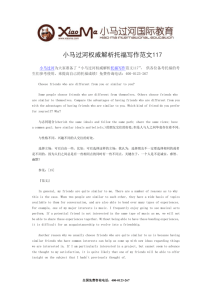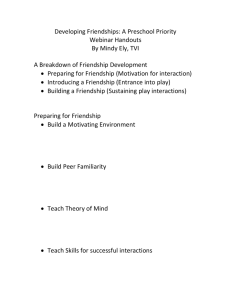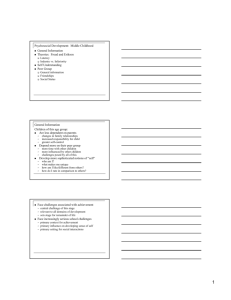Social Development and the Importance of Play
advertisement
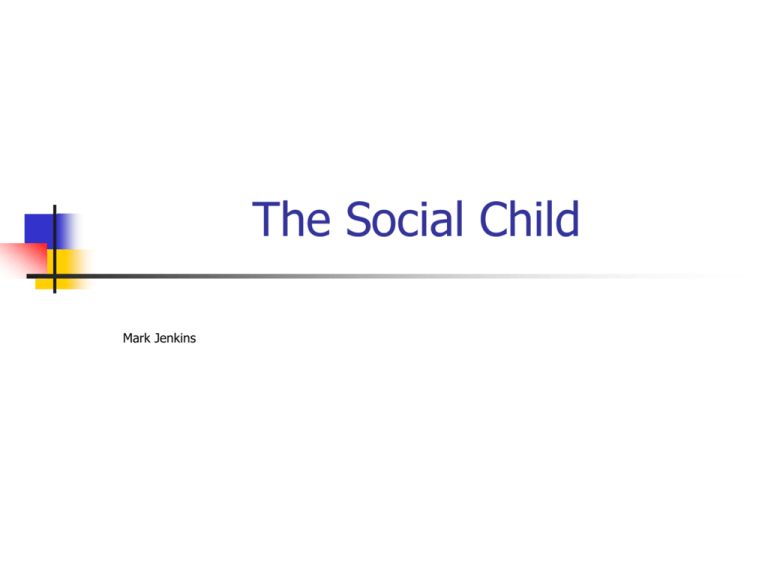
The Social Child Mark Jenkins Major Play Theorists Friedrich Froebel, his kindergarten [child’s garden- the name reflects the philosophy] aspired to the view that play fostered enjoyment, emotional well-being and was a fundamental source of benefit Rudolf Steiner, Steiner-Waldorf schools, play should predominate from birth to 7, it strengthens the imagination and supports all aspects of development. It enables children to concentrate, be inventive and adaptable Susan Isaacs, with gentle guidance children could make sense of the world for themselves. Children’s fantasies should not be curbed and children’s questions should always be answered seriously and respectfully The Importance of Play Play is vital for children’s all round development. It provides opportunities for: Developing confidence, self-esteem and a sense of security Realise their potential and feel competent Use creativity and imagination Develop thinking, reading, problem-solving and motor skills Learn to understand the world around them and their emotions Learn relationship and social skills, and develop values and ethics Piagetian Viewpoint Children’s relationships with adults are qualitatively different from their relationships with children Adults – Vertical Dimension Power assertion and dominance, children falling below adults Children – Horizontal Dimension A more balanced and egalitarian relationship Piaget characterized young children as egocentric and thus incapable of understanding others until middle childhood Social Learning Viewpoint Children learn about their social world and how to react within it through their interactions with peers Either: Directly through children teaching one another Or Indirectly through the observation of others Types of Play Cooperative play – Includes formal games, social pretend play, constructive play. Rare before the age of 3 years Associative play – Children talk to one another and share the same materials but do not take on different roles in an imaginary context or work toward the same goals Parallel play – They play beside, rather than with other children Unoccupied play – Does not play with anything but simply watches other interactions, events and things of interest Solitary play – Children play by themselves in a way which is noticeably different from those around them Parten 1932 Social Functions of Play Piaget, social interactions which occur within play are essential for driving cognitive development Vygotsky, play builds mental structures from the culture surrounding the child, such as language and number Play allows children to explore their social world by adopting various roles and interaction patterns thereby promoting social development Developing Peer Relationships From an early age children are more often found with child companions than adult companions. Harris [1998] and Pinker[2002] controversially suggest that socialization takes place primarily in the peer group rather than the family Friendship Defined as a relationship between two or more which involves commitment and reciprocity [Hartup 1989] Liking is an important part of friendship but is not a sufficient condition on its own to develop friendship The focus of friendship changes with age Friendship is at the Heart of Social Competence Level 1 [5-7] Friends momentary or transient, friends are playmates who share and are fun Level 2 [8-10] Based on issues of trust and of what one likes about the other person Level 3 [11+] Friendship based on intimacy and mutual understanding Damon1977 Early friendships are fragile Friendship offers a context for transmitting social norms, promoting loyalty and alliance. Friendship offers companionship Role Taking The ability to see something from another’s point of view Selman’s 5 stage model Level 0 Child does not distinguish between own and child’s perspective Level 1 Can recognise that they and another have different perspectives, find others view difficult to describe Level 2 See themselves from another’s perspective and know they are similarly capable Level 3 Recognizes how a third person perceives the situation Level4 Understands that a network of perspectives exists that binds individuals into a social system Social Information Processing 1. 2. 3. 4. 5. Encode the cues Interpret the cues Access or construct appropriate responses Evaluate the likely effect of the responses and select the most suitable Enact the chosen response This pro-social model has been used to locate the problems rejected aggressive children have in dealing with their peers The Developmental Course of Peer Interaction Infancy By 6 Months – Take an interest in other infants, increased vocalization and smiling around peers By 12 Months – Clear interest shown in peers, display emotional expressions to peers By 2 years – Mainly Parallel play Understanding rules of social exchange First evidence of pro-social behaviour, such as empathy. Use of language in social exchange. Child operates according to desire psychology The Developmental Course of Peer Interaction Early Childhood By 3 Years – Begins to engage in cooperative play Dominance hierarchies observed in children’s peer group By 4 Years – Mostly Associative play Conflict is observed in children’s relationships The Developmental Course of Peer Interaction Middle and Late Childhood By 6 Years – Sharp increase in the time spent with peers Friendship is regarded as shared interests and the maintenance of successful play By 9 years – The goal of friendship is gaining peer acceptance The Developmental Course of Peer Interaction Adolescence Early Adolescence – Friendship is centred on intimacy and self-disclosure The peer group is organised around cliques and crowds Adolescent egocentrism makes its appearance Late Adolescence – Friends are seen as increasingly a source of emotional and social support. Adolescent egocentrism declines Adolescent Egocentrism The emerging recognition that one may be the focus of another’s attention This leads to a high degree of self-consciousness [the belief that their behaviours are constantly the focus of other’s thoughts An excessive preoccupation with self may interfere with the necessary attention to others perspectives underlying social competence Egocentrism decreases as adolescence progresses Determinants of Peer Acceptance Based on Social skills Personal characteristics Names Physical Appearance [more important to girls than boys] Sex Age The common factor in our society is SIMILARITY Peer Status Based on Socio-metric testing, 5 Categories Popular high on most liked, low on least liked Controversial high on both most and least liked Neglected low on both low and least liked Average some positive, some negative Rejected low most liked high on least liked Rejected Children 1. 2. Aggressive – high levels of behaviour problems, poor self-control, high levels of aggression Non-aggressive – largely socially unskilled, withdrawn, anxious Consequences of Low Peer Status One of the best predictors of academic failure is rejection by the peer group Rejected children were perceived by peers and teachers as weak students They are significantly more likely to drop out of school They feel social dissatisfaction and loneliness. The feel poorly about their own social competence The friendship networks of aggressive rejected children are likely to comprise other aggressive rejected children. This deviant peer group reinforces and supports the rejected aggressive child’s inappropriate behaviours Delinquency The legal definition of anti-social behaviour, includes crimes such as vandalism and shoplifting which do not harm people directly Early starters – those who are aggressive rejected at primary school [likely re-offenders] Late starters – those who follow a more normal developmental path but show some antisocial behaviour for a period, a risk taking perception usually from about 15 but desist after a time
